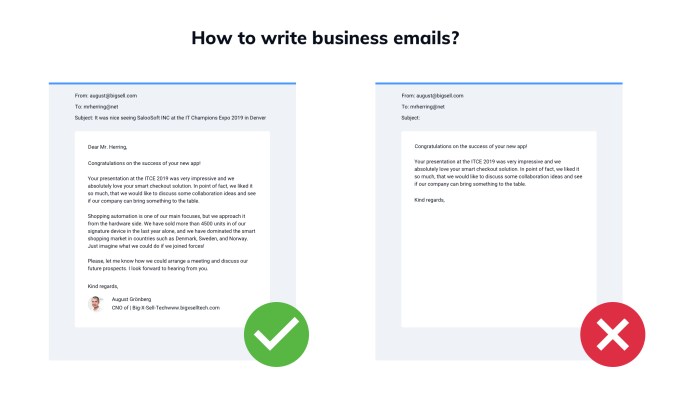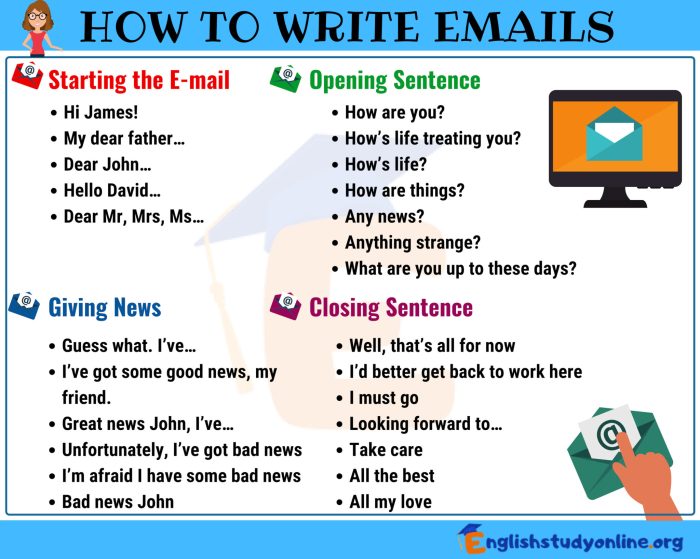Embark on a journey to master the art of crafting the perfect email in just five straightforward steps. Delve into the realm of effective communication that captivates readers and leaves a lasting impression.
Explore the fundamental pillars of email writing, from structuring to subject lines, and elevate your communication game to new heights.
Steps to Write the Perfect Email

When it comes to crafting the perfect email, there are five simple steps that can make a significant difference in the impact and effectiveness of your message. By following these steps, you can ensure that your emails are clear, concise, and professional, leading to better communication and outcomes.
Step 1: Clear Subject Line
A clear and concise subject line is crucial for grabbing the recipient’s attention and giving them a preview of what the email is about. For example, instead of a vague subject line like “Meeting,” opt for something more specific such as “Agenda for Monday’s Team Meeting.” This helps the recipient understand the purpose of the email at a glance.
Step 2: Concise and Relevant Content
Keep your email content brief and to the point. Avoid unnecessary information or lengthy paragraphs that can confuse the recipient. Be sure to include only relevant details that are necessary for the recipient to understand the message. For instance, if you are requesting feedback on a project, provide a clear and concise overview of what you need feedback on.
Step 3: Professional Tone and Language
Maintaining a professional tone and language in your emails is essential for creating a positive impression. Avoid using slang, abbreviations, or informal language that may come across as unprofessional. Always proofread your emails for grammar and spelling errors to ensure clarity and professionalism.
Step 4: Proper Formatting
Proper formatting, such as using bullet points, numbered lists, and paragraphs, can make your email easier to read and understand. Organize your content in a logical and structured manner to help the recipient navigate through the information smoothly. Utilize formatting tools like bold or italics to emphasize important points.
Step 5: Call to Action
End your email with a clear call to action to prompt the recipient on what steps they need to take next. Whether it’s scheduling a meeting, providing feedback, or responding to a question, make it easy for the recipient to know what is expected of them. For example, you can use phrases like “Please let me know your availability for a call next week” to guide the recipient on the next steps.
Crafting the Subject Line

Crafting a compelling subject line is crucial when it comes to email communication. It is the first thing recipients see, and it determines whether they will open the email or not. A well-crafted subject line can grab the reader’s attention and entice them to open the email, while a poorly written one may lead to the email being ignored or deleted.
Significance of a compelling subject line
- A compelling subject line increases the chances of your email being opened by the recipient.
- It sets the tone for the email and gives the recipient an idea of what to expect.
- An attention-grabbing subject line can help you stand out in a crowded inbox and increase engagement.
Tips on creating attention-grabbing subject lines
- Keep it short and concise to ensure it is fully visible on all devices.
- Use action-oriented language to prompt the recipient to take a specific action.
- Personalize the subject line by including the recipient’s name or referencing previous interactions.
- Create a sense of urgency or exclusivity to encourage immediate action.
- Avoid using all caps or excessive punctuation, as it can come across as spammy.
Examples of effective subject lines and their impact on email open rates
-
“Don’t Miss Out on Exclusive Deals – 24 Hours Only!”
– This subject line creates a sense of urgency and exclusivity, leading to a higher open rate.
-
“Sarah, Your Personalized Offer Awaits Inside…”
– By personalizing the subject line, the recipient is more likely to open the email out of curiosity.
-
“Last Chance to Register for Our Webinar Tomorrow!”
– The subject line conveys urgency and prompts immediate action, resulting in a higher open rate.
Structuring the Email Content

When structuring an email, it is essential to follow a clear and organized format to ensure that your message is effectively communicated to the recipient. The ideal structure for an email includes an introduction, body, and conclusion. Each section plays a crucial role in delivering your message in a professional and concise manner.
Maintaining a Professional Tone
To maintain a professional tone throughout your email, it is important to use formal language and avoid slang or abbreviations. Keep your sentences clear and concise, and use correct grammar and punctuation. Remember to address the recipient respectfully and avoid using overly casual language. This will help you come across as professional and respectful in your communication.
Organizing Information Effectively
When organizing information within the email, it is important to prioritize the most important points at the beginning of the email. Use bullet points or numbered lists to highlight key information and make it easy for the recipient to skim through the content. Additionally, make sure to use paragraphs to separate different ideas and topics, ensuring clarity and impact in your message.
End of Discussion

Conclusively, mastering the art of writing the perfect email in five simple steps equips you with the skills to communicate effectively, leaving a mark on your recipients and achieving your communication goals effortlessly.